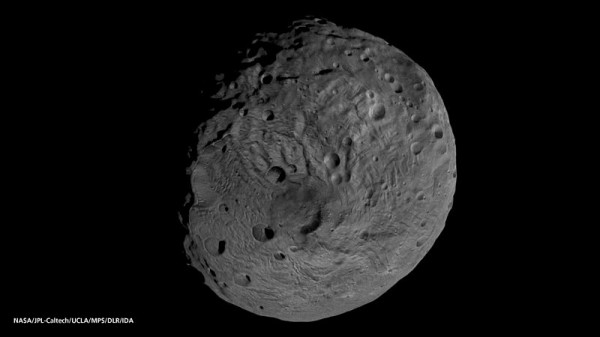
This is Vesta, the second largest asteroid in our solar system's main asteroid belt. Specifically, this is a view of Vesta's south pole, taken by NASA's Dawn spacecraft last September.
As it turns out, Vesta is a great illustration of the power of chance in the universe. Data collected by Dawn is showing that, once upon a time, this asteroid was on its way to planethood. But, for several reasons, it simply never grew large enough. From Science News:
... according to Dawn observations, Vesta did indeed agglomerate enough rocky debris as it grew to heat itself by the decay of the rock's radioactive elements. That heat led to the separation of the primordial body into a rocky crust, an underlying rocky mantle, and a central metallic core, hallmarks of planet Earth and the other rocky planets. Dawn was the first to detect Vesta's now-solid core.Vesta isn't unique in this, but it does provide an interesting moment to stop and think a little bit about randomness and the process of planetary birth. This news about Vesta is a nice reminder that there's really no reason why our solar system has to have eight planets. It could have had fewer. It could have had more. And some bodies—like Ceres and Pluto—are really only a trick of taxonomy away from being planets.
Since slipping into orbit around the solar system's second-most massive
asteroid last July, NASA's Dawn spacecraft has confirmed Vesta's status as a body whose arrested growth
denied it true planethood. In a series of papers published online today in Science, researchers report that according to Dawn observations,
Vesta did indeed agglomerate enough rocky debris as it grew to
heat itself by the decay of the rock's radioactive elements. That
heat led to the separation of the primordial body into a rocky crust, an
underlying rocky mantle, and a central metallic core, hallmarks of
planet
Earth and the other rocky planets. Dawn was the first to detect
Vesta's now-solid core. The trick was to record its subtle gravitational
signature during
many orbits of the asteroid. Vesta also grew large enough to survive
a massive battering about a billion years ago that formed the
500-kilometer-wide
Rheasilvia impact crater and its 22-kilometer-high central mound
(above). But at a diameter of only 530 kilometers, Vesta was not quite
massive enough to
pull itself back into a sphere after the Rheasilvia impact. And,
like the rest of the asteroids, it stopped growing far short of the mass
needed to
gravitationally clear other bodies from the vicinity of its orbit.
That was Pluto's downfall, as well.
See more ScienceShots.
See more ScienceShots.